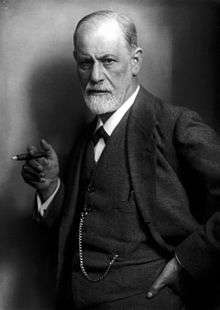Phallic stage
| Part of a series of articles on |
| Psychoanalysis |
|---|
 |
|
Important figures
|
|
Important works
|
|
Schools of thought |
|

In Freudian psychoanalysis, the phallic stage is the third stage of psychosexual development, spanning the ages of three to six years, wherein the infant’s libido (desire) centers upon his or her genitalia as the erogenous zone. When children become aware of their bodies, the bodies of other children, and the bodies of their parents, they gratify physical curiosity by undressing and exploring each other and their genitals, the center of the phallic stage, in course of which they learn the physical differences between “male” and “female”, and the gender differences between “boy” and “girl”, experiences which alter the psychologic dynamics of the parent and child relationship.[1] The phallic stage is the third of five Freudian psychosexual development stages: (i) the oral, (ii) the anal, (iii) the phallic, (iv) the latent, and (v) the genital.
Complexes: Oedipus and Electra
In the Phallic stage of psychosexual development, a boy’s decisive experience is the Oedipus complex describing his son–father competition for sexual possession of mother. This psychological complex indirectly derives from the Greek mythologic character Oedipus, who unwittingly killed his father and sexually possessed his mother. Initially, Dr. Freud applied the Oedipus complex to the development of boys and girls alike; he then developed the female aspect of phallic-stage psychosexual development as the feminine Oedipus attitude and the negative Oedipus complex;[2] but his student–collaborator Carl Jung proposed the “Electra complex”, derived from Greek mythologic character Electra, who plotted matricidal revenge against her mother for the murder of her father, to describe a girl’s psychosexual competition with her mother for possession of her father.[3]
Oedipus

Despite mother being the parent who primarily gratifies the child’s desires, the child begins forming a discrete sexual identity — “boy”, “girl” — that alters the dynamics of the parent and child relationship; the parents become the focus of infantile libidinal energy. The boy focuses his libido (sexual desire) upon his mother, and focuses jealousy and emotional rivalry against his father — because it is he who sleeps with the mother. To facilitate uniting him with the mother, the boy’s id wants to kill his father (as did Oedipus), but the ego, pragmatically based upon the reality principle, knows that his father is the stronger of the two males competing to psychosexually possess the one female. Nonetheless, the fearful boy remains ambivalent about his father’s place in the family, which is manifested as fear of castration by the physically greater father; the fear is an irrational, subconscious manifestation of the infantile Id.[4]
Electra

In developing a discrete psychosexual identity, boys develop castration anxiety and girls develop penis envy towards all males. The girl’s envy is rooted in the biologic fact that, without a penis, she cannot sexually possess mother, as the infantile id demands, resultantly, the girl redirects her desire for sexual union upon father. She thus psychosexually progresses to heterosexual femininity (which culminates in bearing a child) derived from earlier, infantile desires; her child replaces the absent penis. Moreover, after the phallic stage, the girl’s psychosexual development includes transferring her primary erogenous zone from the infantile clitoris to the adult vagina. Freud thus considered a girl’s Oedipal conflict to be more emotionally intense than that of a boy, resulting, potentially, in a woman of submissive, less confident personality.[5]
Defense mechanisms
In both sexes, defense mechanisms provide transitory resolutions of the conflict between the drives of the Id and the drives of the Ego. The first defense mechanism is repression, the blocking of memories, emotional impulses, and ideas from the conscious mind; yet it does not resolve the Id–Ego conflict. The second defense mechanism is identification, by which the child incorporates, to his or her ego, the personality characteristics of the same-sex parent; in so adapting, the boy diminishes his castration anxiety, because likeness to father protects him from father’s wrath as a rival for mother; by so adapting, the girl facilitates identifying with mother, who understands that, in being females, neither of them possesses a penis, and thus are not antagonists.[6]
Unresolved fixation
Unresolved sexual competition for the opposite-sex parent might lead to a phallic-stage fixation conducive to a girl becoming a woman who continually strives to dominate men (viz. penis envy), either as an unusually seductive woman (high self-esteem) or as an unusually submissive woman (low self-esteem). In a boy, a phallic-stage fixation might be conducive to becoming a vain, over-ambitious man. Therefore, the satisfactory parental handling and resolution of the Oedipus complex and the Electra complex are most important in developing the infantile super-ego, because, by identifying with a parent, the child internalizes Morality, thereby, he or she chooses to comply with societal rules, rather than having to comply reflexively, from fear of punishment.
See also
References
- ↑ “Sigmund Freud 1856–1939” entry (2000) Encyclopaedia of German Literature Routledge:London Retrieved 2 September 2009: http://www.credoreference.com.library.capella.edu/entry/routgermanlit/sigmund_freud_1856_1939
- ↑ Freud, Sigmund (1956). On Sexuality. Penguin Books Ltd.
- ↑ “Sigmund Freud 1856–1939” entry (2000) Encyclopaedia of German Literature Routledge:London Retrieved 2 September 2009: http://www.credoreference.com.library.capella.edu/entry/routgermanlit/sigmund_freud_1856_1939
- ↑ Bullock, A., Trombley, S. (1999) The New Fontana Dictionary of Modern Thought Harper Collins:London pp. 607, 705
- ↑ Bullock, A., Trombley, S. (1999) The New Fontana Dictionary of Modern Thought Harper Collins:London pp. 259, 705
- ↑ Bullock, A., Trombley, S. (1999) The New Fontana Dictionary of Modern Thought Harper Collins:London pp. 205, 107
External links
- Freud's Psychosexual Stages.
- Felluga, Dino. "Modules on Freud: On Psychosexual Development". Introductory Guide to Critical Theory. West Lafayette, Indiana: Purdue University College of Liberal Arts.